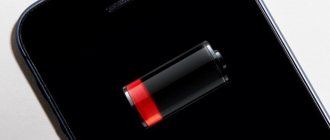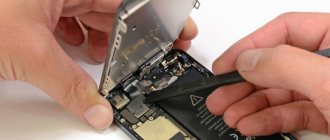A modern telephone is a complex technical device, sometimes in no way inferior to a regular computer. Underneath the plastic or metal casing lies a powerful processor that performs the most complex tasks. During its operation, thermal energy is inevitably released, so the phone inevitably heats up. And the more complex tasks the user sets for the phone, the more the device heats up.
In most cases, a phone heating up during operation should not bother the owner. The manufacturers of the device studied physics and made sure that the inevitably released thermal energy could not damage the technical inside of the gadget. It is constant overheating that is dangerous - when the phone heats up to a temperature of 50-70 degrees, this happens often and no longer has a direct relationship with the use of the phone.
The weakest link is the battery. Lithium, one of its constituent parts, is a very active metal with a low melting point. For such batteries, the upper operating temperature is 60 degrees. It is harmful for him to constantly stay in conditions where the temperature around him is elevated. At first it will discharge faster, then it may stop working altogether. When storing a battery at a temperature of 50 degrees, capacity degradation increases sixfold, according to researchers.
In second place is the display matrix; it can also fail, or some of its sections may be damaged.
The parts of the processor and motherboard themselves are most often capable of operating at a temperature of 70-85 degrees. A slight overheating due to work or long conversations cannot harm them, but if the phone heats up to such a temperature, this is already a reason to run to the service center.
The phone gets warm when talking
The smartphone has a transmitter, which is responsible for communication. During a conversation, it works continuously, so the device heats up. He has to constantly exchange data, both for reception and transmission. And the longer the conversation lasts, the hotter the phone gets. If the connection is not very good, for example, you find yourself in a country house or in the forest, it will need more power to “reach” the tower, which means the phone will turn into a burning brick even faster.
What to do?
There is nothing to worry too much about, however, it is worth remembering: an overheating phone increases radiation. When talking, you hold it next to your head - this can negatively affect your health. It is recommended to use a headset or reduce the call time. After a long conversation, you should let the phone “cool down” without using it for some time.
How to unlock iPhone
What to do if you forgot your password and in other emergency situations
During a conversation
The phone does not heat up immediately during a call, but after 10–15 minutes. The temperature increase in most modern devices occurs at the top. There is a transmitter located there, thanks to which the smartphone picks up the mobile network.
During a call, the sensor operates continuously - constantly transmitting data. When a call occurs in an area that is poorly covered by the operator, the sensor begins to work more powerfully to pick up communications from the towers.
Overheating during a call is not considered a malfunction. When your device starts to heat up, shorten your call time or use a headset. It is recommended to do this so as not to spoil your health, since an overheated smartphone increases radiation.
The phone gets warm when charging
The reason may be the use of the wrong charger: non-original, faulty. In this case, the phone may be supplied with more voltage than it needs, and some kind of microcircuit will have to extinguish the excess, hence the heating.
What to do?
Use the original adapter purchased at the store to charge your smartphone. The cost of saving is the possible replacement of the battery, which may be required, and this is not a very cheap pleasure. Try not to use the phone while charging, and especially not to load heavy files at this moment, do not turn on games.
Why cool your phone?
If low temperatures can create temporary difficulties when using a smartphone, then high temperatures can be critical for its normal operation in the future. They can cause irreversible effects that you cannot deal with on your own. In the best case, service intervention will be required, in the worst case, the purchase of a new device.
- CPU slowdown . When overheated, the main chip of the smartphone begins to reduce the frequency and speed. This phenomenon is called “throttling”, and is considered temporary, that is, it disappears after the temperature drops. However, regular overload of the processor with activated games, heavy applications, in combination with a connected charger, can interfere with passive cooling
- Internal battery corrosion . When the battery is regularly overheated, oxidative reactions can occur inside the battery on the electrolyte or electrodes. This leads to shortened battery life and rapid failure.
- Formation of artifacts on the display . While navigating with the charger connected, yellow stripes may appear on the smartphone screen over time. This is due to a critical increase in temperature, which leads to overheating of the screen and “setting it on fire” from the inside.
- Violation of the integrity of components . A regular increase in temperature inside a smartphone, which occurs regularly, can render internal and external components unusable: motherboard, transmitters, etc.
Phone gets hot due to background apps
The greatest concern for phone owners is when their gadget starts to heat up for no apparent reason. It seems that the phone is lying idle on the table, but nevertheless the temperature of the device rises and after some time it is impossible to pick it up without getting burned. The thing is that a modern smartphone can live an active life without human intervention. For example, on a moving train, it will constantly check the network, and this means continuous operation of the transmitter. When at rest, the phone is constantly connected to the network to check incoming messages in instant messengers, download weather widgets, and updates. If you have a large number of applications running in the background, then your phone almost never rests.
What to do?
Use any program that allows you to clear your smartphone’s RAM. In most versions of Android, this can be done using the available utilities. However, third-party programs allow you to better find all running processes and stop unnecessary ones. Also, get into the habit of “tidying up” your smartphone more often: don’t leave 100 open tabs in the browser, close applications that you no longer use, and don’t just minimize them.
The phone gets hot when playing games
This is also a standard situation, especially when it comes to complex games with good graphics. To run such applications, you need all the power of the processor, which works at full capacity, which means it heats up more than usual. Too much overheating indicates that your device cannot handle a particular application.
What to do?
If your smartphone is not powerful enough, do not try to run too heavy games on it. Take breaks during heavy use by turning off all applications completely and allowing your smartphone to cool down. If you are downloading heavy files, pause the process. You should not play in stuffy public transport or, for example, in the heat on the beach. A combination of several reasons can lead to overheating.
In most cases, a phone heating up during operation should not bother the owner. Photo: pixabay.com
Why your phone overheats and how to fix it
If your phone is getting warm or overheating, there are a number of possible reasons. Whether you use an iPhone or an Android device, find out what makes your phone so hot, how to fix the problem, and how to prevent it from happening again.
Why does my phone get hot?
In fact, there is no single answer to this very common question. Let's try to understand this really hot issue. Please note that if your phone gets warm from time to time, this is generally normal. After all, after all, this is an ordinary electronic device, and all electrical devices create heat in one way or another during operation. This is fine!
But if your phone regularly gets hot to the point that it's uncomfortable to hold, it could be a much more serious problem that could ultimately speed up your phone's aging process.
Why is it heating up?
When your phone's temperature rises, the most likely culprits are the battery, processor, or screen. Each of these components can generate heat; the chemicals in your phone's battery create electricity, the processor transmits information at high speed (like a computer), and your phone's screen emits light. So how can you determine the cause of the problem? While it's not an exact science, you can make an educated guess as to why your iPhone or Android phone gets hot depending on where the heat is coming from.
Back of the phone
If the back of the phone gets hot, the problem may be that the battery is overheating. Most modern mobile phones use lithium-ion batteries, which, despite their size, have a large charge. Lithium-ion batteries are generally safe, but malfunctions sometimes occur, as seen when the Samsung Galaxy Note7 battery exploded. A hot battery can also be a sign that it needs to be replaced.
Bottom of the phone
See if the bottom of the phone gets hot while charging - if it does, the problem may be with the charger. Whether you use an iPhone or Android, the most reliable charger will be from your phone's manufacturer. But contrary to popular belief, third-party chargers are just as good as long as they're purchased from a reputable source.
Please note that using unauthorized chargers can lead not only to overheating, but also to fire of your smartphone.
Above the battery, speaker or screen
If you notice that your phone is getting warm somewhere other than the battery or the bottom where it connects to the charger, then look into other possible causes, which could be related to either the phone itself or external factors.
Hot or warm - what's the difference?
It should be understood that a “warm” phone is not the same as a “hot” phone. Typically, your phone's internal temperature can reach 37-43 degrees Celsius (98.6-109.4 degrees Fahrenheit) and still be considered normal.
If you're using an Android phone, you can install a great app called AIDA64, which will give you a ton of information about your phone's hardware and software, including a temperature report. While Apple expanded the information you can see in the Battery Health menu in its latest iOS 12.3 update, alas, the app doesn't include temperature readings. However, since we've already established that it's normal for your phone to warm up some, it's better to determine overheating based on how often you notice your phone getting warm, or if the temperature is physically uncomfortable. Your phone shouldn't get hot several times a day or for seemingly no reason.
Reasons for phone overheating
There are a few completely normal (and harmless) reasons why your phone might need more power than usual, causing it to get a little warm. These include:
Long periods of time when you play
Unless you've spent many hours marathoning Candy Crush or Snake vs. Block”, then you are either lying or you have never had to use public transport. The sheer number of available games for mobile applications is perhaps one of the main reasons for purchasing a smartphone. However, high-intensity gaming apps use your phone's CPU in addition to the GPU, which can heat up your phone.
Streaming Content
Just like in a gaming scenario, watching YouTube or Netflix for several hours through your Android or iPhone is another surefire way to overload your phone's processor as it has to load video data and keep the display active for an extended period of time. time.
Your settings are not optimal
Your phone's settings also affect how much power it uses. Is the screen brightness at full power? Animated wallpaper? Widgets, widgets everywhere? Try turning off (or reducing, in the case of screen brightness) unnecessary settings to reduce the load on your phone's processor.
Other causes may not be related to your phone's normal processes, but they are still relatively easy to fix.
Environmental factors
Be prepared that leaving your phone outside in the sun or in a car on a hot day can cause it to overheat. This will also prevent the touch screen from working and drain the battery faster. In addition to sun and heat exposure, water damage can also cause your phone to overheat.
Application updates
If there is a bug or other problem with the app, it may cause your phone to overheat due to excessive use of your device's CPU. Keeping your apps up to date is important because updates often include bug fixes.
Software updates
In rare cases, the phone may overheat either after an update or due to a bug in the OS that required fixing by installing an update. There was a case in my practice when an acquaintance approached me with a request for help. After installing the update, his phone began to use the battery much more intensively, resulting in the need to charge the phone twice a day. At the same time, the phone became very hot. A solution to the problem has been found. We made a backup, reset the phone to factory settings and restored it. All. The phone worked fine without overheating.
A big problem
While there are many plausible explanations for why your phone is heating up, it's best not to assume there's a simple solution to the problem. An overheating phone could be a sign that your phone is infected with malware. Malware often consumes a lot of phone memory and a lot of CPU resources, causing the phone to overheat. Some types of malware can even physically damage your phone.
Since the Bitcoin explosion, the cryptocurrency has come to the forefront of hackers' interests. Last year, a malicious Trojan called Loapi infected Android phones by masquerading as a fake antivirus app on the Google Play Store. Loapi malware was used by hackers to secretly mine the Monero cryptocurrency. This dramatically increased the processing power of the processor and caused the device to overheat, causing the phone's battery to visibly swell just two days after infection.
There is also a growing number of fake Android apps infecting devices with CoinHive, another cryptocurrency mining malware. Hidden inside HTML files in the application's resources folder, the mining script is activated once the application is opened and continues to run in the background completely out of sight. Since many of these malicious apps have been found on the Google Play Store, paying attention to whether your phone is overheating can help you identify a malware infection.
Using a reliable mobile antivirus is the best way to prevent malware from harming your Android phone, and while this scenario is much less common on the iPhone, it can still happen.
How to cool down your phone
For quick cooling, try removing the case from your phone first. While the case itself shouldn't cause your phone to overheat, it can trap heat. Removing the case can help lower your phone's temperature faster. Then turn on Airplane mode to quickly turn off battery-draining features like wireless radio, Bluetooth and Wi-Fi, or cellular signal scanning. This isn't the most practical option, but it can help quickly cool down your phone if it's overheated.
Also, NEVER put your phone in the refrigerator or freezer. Exposing your phone to extreme temperatures or moisture can cause irreparable damage.
Both iPhone and Android are designed to operate in temperatures between 0 and 35 degrees Celsius (32-95 Fahrenheit), but exposure to temperatures outside this range may have a negative impact on your phone's performance or hardware. If your phone is overheating due to direct sunlight or heat, you can move it to a darker place.
In addition to the tips mentioned above, there are a few other things you can do to help your phone cool down:
- Use less power —Low Power Mode on iPhone and Low Power Mode on Android reduce your phone's power consumption and also help extend the life of your phone's battery.
- Installing anti-spam software is another useful way to minimize your phone's battery and processor usage. Apps to clean your phone make it easy to clean up junk files, identify apps that are slowing down your phone, and remove unnecessary pre-installed apps to improve your phone's performance and extend its battery life.
- Lower your screen brightness – Keeping your screen brightness at a reasonable level (not at full power) will put some strain on your phone battery (and your eyes).
- Turn off Wi-Fi, GPS, and Bluetooth —turning off features like battery drain causes your phone to stop working and run cold.
- Reboot your phone. Sometimes restarting your phone can help prevent overheating due to minor software issues.
How to prevent your phone from overheating
Prevention is often better than cure, even when it comes to your phone overheating. Developing some basic phone care habits really makes a difference when it comes to extending the life of your phone or preventing you from having to replace it entirely.
Charge your phone correctly
We've already mentioned using an authorized charger, but where you place your phone while charging is also important. Place it on a hard surface that will not conduct heat; not on your sofa or bed, which will retain the heat generated when charging.
Update installed applications
If you notice that your phone is starting to get warm for no apparent reason, try checking your recently installed apps. It's possible that one or more of them contain bugs that are causing your phone to overheat. Updating applications usually resolves this issue; If not, try uninstalling the app to determine if it is causing your phone to overheat.
Avoid direct sunlight
This sounds like "boring" advice, but it's pretty easy to forget about your phone when you're outside soaking up the sun. Cover your phone to keep it from overheating - you may need to sunbathe, but your phone is definitely not designed for that.
Use antivirus (Android)
It really cannot be stressed enough how important it is to use antivirus software on your Android phone. Apart from overheating, getting malware on your phone will at the very least cause a huge headache. This could lead to your sensitive information being leaked, your bank details being stolen, your identity being stolen, your physical location being spied on, your battery draining - the list goes on, but the bottom line is that your smartphone will no longer be yours at all. Be sure to use an antivirus.
The phone gets hot due to WI-FI, Bluetooth, 3G
If you have all your data technologies running all the time, as well as your GPS sensor, don't be surprised if your phone is constantly running hot. Of course, these are not such big “degrees”, but all simultaneously running modules can collectively lead to overheating.
What to do?
Disable the constant search for WI-FI, do not leave the navigation module constantly on, especially if you are not driving and are not driving using the navigator right now. When you use wireless Internet, turn off your mobile Internet. Also turn it off on a train or plane - when there is no network, the transmitter does not calm down for almost a minute, trying to “reach out” to the transmitting tower. And it not only makes the phone overheat, but also drains the battery.
Option 5: Heating during idle time for no apparent reason
The most unpleasant option is the increased temperature of the device during basic tasks such as making calls, browsing the Internet, or communicating in instant messengers. Here we can give the following recommendations:
- If you are using third or fourth generation mobile Internet, make sure that your smartphone is in a good reception area.
It is the network module that heats up the most, especially when the signal is weak. If you encounter the latter (the indicator displays less than 2 bars), it is better to turn off mobile data transfer as soon as possible. It also makes sense to switch the network module to forced operating mode - 2G/3G or simply 3G, instructions below. Read more: How to change the network operating mode - The statements from the step above are also true for Wi-Fi, so turn it off if you are out of range.
- Also turn off all means of transmitting and receiving data if you do not need them at this moment: Bluetooth, GPS, NFC. As a bonus to lower temperatures, you will also receive a slightly increased battery life.
- If none of the instructions above and the present one helped you, in this case you can assume a hardware problem - alas, even such industry giants as Samsung are also susceptible to defects, just remember the story with the Galaxy Note 7. In such a situation, there is only one solution - visit to a service center, preferably authorized by a Korean corporation.
Unfortunately, as practice shows, an increase in the temperature of the phone during idle time in most cases means a hardware failure.
We are glad that we were able to help you solve the problem. In addition to this article, there are 12,719 more instructions on the site. Add the Lumpics.ru website to your bookmarks (CTRL+D) and we will definitely be useful to you. Thank the author and share the article on social networks.
Describe what didn't work for you. Our specialists will try to answer as quickly as possible.
The phone gets hot due to software errors
Poorly designed applications do not use operating system resources well. As a result, they send incorrect commands to the technical part of the smartphone, which reacts incorrectly to them and, trying to understand the confusing instructions, the processor begins to work unnecessarily hard.
What to do?
Find out which program is causing the overheating and remove it. Update the programs installed on the gadget, as developers are constantly “fixing” errors. In general, try not to keep unnecessary and unused programs in stock. This will help save space and keep your phone from heating up.
The phone fell into the water
What actions should you take first?
Software errors
Not all installed applications work properly. Some of them may not be finalized at the code level. In this case, it is easy to answer why the smartphone is heating up: the application is not functioning correctly. Problems lead to increased operation of the mobile device, as the gadget tries to improve the process.
The reasons for application problems are as follows:
- the developers did not finalize the program code;
- the application was hacked to obtain confidential user data;
- the program was downloaded from an unofficial source.
To eliminate overheating and avoid damaging your device, find out which application is causing the high temperatures. When you find it, delete it. If the program has no alternative and is needed for work, then check if there are updates for it. Otherwise, it is recommended not to keep unnecessary and superfluous applications on the device.
Your smartphone gets hot when you watch a movie
This is especially inconvenient if you have to hold the phone in your hands while viewing. Most often, a movie cannot cause the phone to overheat; the increase in temperature that occurs will not harm the gadget, so there is no reason to worry.
What to do?
It is normal for the device to heat up during active use. If you are going to watch an hour-long movie, for example, on a plane or train, think about how to secure the gadget. It is best to make a stand on which it will be in a vertical position. Take breaks. Turn off running modules, including mobile Internet, and stop downloading heavy files.
↑ Phone overheating, when it’s normal, and when it’s already a malfunction.
Often, there are situations when overheating of a smartphone is not immediately a malfunction of the gadget.
Users believe that it depends on the power of your device. Normal phone overheating can be caused by:
- high brightness of the screen, which is active for a long time;
- prolonged surfing the Internet and watching video content;
- exposure to sunlight and heat;
- weak mobile operator network signal;
- processor heat, which is dissipated through the back of the smartphone.
If the Android smartphone heats up only for the above reasons and works normally, then there is no need to look for problems with it. Excessive temperatures cannot be considered the cause of device malfunctions.
Extreme heating of the gadget can be considered a problem in the following cases:
- overheating in standby mode;
- overheating after switching off;
- fact of fast discharge;
- overheating of certain areas of the body;
- freezing or sudden shutdown;
- strong heating during charging process.
Sometimes during the charging process, not only the smartphone itself, but also the power adapter can heat up. At the same time, the battery can also heat up and even increase in size so much that the lid begins to bulge. This battery needs to be replaced urgently; it is not suitable for use.
The phone is warming up in the sun in your pocket
A modern person is nowhere without a phone. However, it is worth remembering that in some conditions it is not recommended to use the technique. The reason for your phone to overheat can be simple exposure to high temperatures. If you read a book on your smartphone on the beach, it will definitely get hot. If you put it in a tight pocket and get stuck in a stuffy bus for an hour, get ready for dangerous heating. Especially if at this time, for example, the device is downloading a heavy movie, or is actively checking instant messengers.
What to do?
Take a paper book with you to the beach. Do not leave your phone lying in direct sunlight. If you put the device in your bag at the beach or on a picnic, do not leave it at the top, rather, bury it deeper. Set the screen to auto-lock so that the camera, call, and other applications do not accidentally launch in your pocket. It’s better to hold your phone in your hands if you have set heavy files to download.
When the phone gets hot, it turns off, reboots, freezes or glitches
Overheating, as a result of which the device spontaneously turns off or reboots, can be caused by two reasons:
- Very poor CPU cooling (shutdown acts as protection against thermal damage).
- Electrical problems.
Freezes can be both a consequence and a cause of overheating. They can be caused by both software and hardware failures. You can deal with the former yourself by deleting recently installed applications, doing a hard reset or reflashing the device, but with the latter you will have to contact service. The main difficulty is to distinguish a software problem from a hardware one.
Various glitches and dysfunctions may be the consequences of overheating or have a common origin with it. For example, a malware that infects a device disables some buttons in the menu, blocks receiving calls, and at the same time creates an excessive load on the processor, causing it to heat up more than usual.
Overheating in combination with artifacts on the screen is always associated with a hardware failure.
The phone gets hot due to the case
Yes, the wrong case can cause your phone to overheat. If you actively use your phone: play games, talk for a long time, watch a long movie, it is better to remove the case so that the case cools faster. In general, the problem can be caused by a case that is too tight.
What to do?
Change the “clothes” of your phone. A good option is silicone cases. They leave enough space to cool the gadget. Remove the case if you use your smartphone to its fullest.
How to recognize a refurbished iPhone
Is it worth saving money by buying a refurbished iPhone?
Overheating due to problems with the operating system
Often the phone starts to heat up due to garbage accumulated in the operating system. These are “hooksticks” of remote programs, a cache of running applications, copies of all photos and videos ever downloaded on the device. With such a background in RAM, the device takes longer to boot, takes longer to search for the necessary information, works slower and gets hotter.
What to do?
First, look in the “Settings - About the system” section to see if your phone has been updated to the latest version of available software. Sometimes for instant cleaning it is enough to simply restart the phone, but if this does not help, you can reset the settings to factory settings, thus removing all the accumulated garbage. Just first you need to save all important data by creating a copy of all contacts in your address book.
Viruses
Sometimes the phone overheats and turns off. This indicates a serious problem that is deeply embedded in the system. One of the reasons for this device behavior is viruses and advertising Trojans. They can penetrate along with the installed application.
Viruses are different. The most common are mining viruses that, unbeknownst to users, force the Android or iOS system to mine cryptocurrency.
For a mobile device, this is a complex process during which the smartphone operates at its limits. The result is severe braking of the system, overheating.
You can eliminate malicious code like this:
- Install an antivirus program on your phone. Use a product from renowned companies.
- Within the application, run a system scan.
- After detecting a virus, remove it by following the steps suggested by the antivirus.
- Repeat the steps with another antivirus program to check.
You can check your smartphone for viruses through your computer. Desktop versions are more advanced. To use them, connect your smartphone to your PC and perform a system check on your smartphone. If you cannot remove the virus through antivirus programs, then roll back your mobile device to factory settings.











